Md. Alamin Talukder
An Integrated Deep Learning Model for Skin Cancer Detection Using Hybrid Feature Fusion Technique
Oct 18, 2024



Abstract:Skin cancer is a serious and potentially fatal disease caused by DNA damage. Early detection significantly increases survival rates, making accurate diagnosis crucial. In this groundbreaking study, we present a hybrid framework based on Deep Learning (DL) that achieves precise classification of benign and malignant skin lesions. Our approach begins with dataset preprocessing to enhance classification accuracy, followed by training two separate pre-trained DL models, InceptionV3 and DenseNet121. By fusing the results of each model using the weighted sum rule, our system achieves exceptional accuracy rates. Specifically, we achieve a 92.27% detection accuracy rate, 92.33% sensitivity, 92.22% specificity, 90.81% precision, and 91.57% F1-score, outperforming existing models and demonstrating the robustness and trustworthiness of our hybrid approach. Our study represents a significant advance in skin cancer diagnosis and provides a promising foundation for further research in the field. With the potential to save countless lives through earlier detection, our hybrid deep-learning approach is a game-changer in the fight against skin cancer.
A Dual-Tier Adaptive One-Class Classification IDS for Emerging Cyberthreats
Mar 17, 2024Abstract:In today's digital age, our dependence on IoT (Internet of Things) and IIoT (Industrial IoT) systems has grown immensely, which facilitates sensitive activities such as banking transactions and personal, enterprise data, and legal document exchanges. Cyberattackers consistently exploit weak security measures and tools. The Network Intrusion Detection System (IDS) acts as a primary tool against such cyber threats. However, machine learning-based IDSs, when trained on specific attack patterns, often misclassify new emerging cyberattacks. Further, the limited availability of attack instances for training a supervised learner and the ever-evolving nature of cyber threats further complicate the matter. This emphasizes the need for an adaptable IDS framework capable of recognizing and learning from unfamiliar/unseen attacks over time. In this research, we propose a one-class classification-driven IDS system structured on two tiers. The first tier distinguishes between normal activities and attacks/threats, while the second tier determines if the detected attack is known or unknown. Within this second tier, we also embed a multi-classification mechanism coupled with a clustering algorithm. This model not only identifies unseen attacks but also uses them for retraining them by clustering unseen attacks. This enables our model to be future-proofed, capable of evolving with emerging threat patterns. Leveraging one-class classifiers (OCC) at the first level, our approach bypasses the need for attack samples, addressing data imbalance and zero-day attack concerns and OCC at the second level can effectively separate unknown attacks from the known attacks. Our methodology and evaluations indicate that the presented framework exhibits promising potential for real-world deployments.
Hierarchical Classification for Intrusion Detection System: Effective Design and Empirical Analysis
Mar 17, 2024



Abstract:With the increased use of network technologies like Internet of Things (IoT) in many real-world applications, new types of cyberattacks have been emerging. To safeguard critical infrastructures from these emerging threats, it is crucial to deploy an Intrusion Detection System (IDS) that can detect different types of attacks accurately while minimizing false alarms. Machine learning approaches have been used extensively in IDS and they are mainly using flat multi-class classification to differentiate normal traffic and different types of attacks. Though cyberattack types exhibit a hierarchical structure where similar granular attack subtypes can be grouped into more high-level attack types, hierarchical classification approach has not been explored well. In this paper, we investigate the effectiveness of hierarchical classification approach in IDS. We use a three-level hierarchical classification model to classify various network attacks, where the first level classifies benign or attack, the second level classifies coarse high-level attack types, and the third level classifies a granular level attack types. Our empirical results of using 10 different classification algorithms in 10 different datasets show that there is no significant difference in terms of overall classification performance (i.e., detecting normal and different types of attack correctly) of hierarchical and flat classification approaches. However, flat classification approach misclassify attacks as normal whereas hierarchical approach misclassify one type of attack as another attack type. In other words, the hierarchical classification approach significantly minimises attacks from misclassified as normal traffic, which is more important in critical systems.
usfAD Based Effective Unknown Attack Detection Focused IDS Framework
Mar 17, 2024Abstract:The rapid expansion of varied network systems, including the Internet of Things (IoT) and Industrial Internet of Things (IIoT), has led to an increasing range of cyber threats. Ensuring robust protection against these threats necessitates the implementation of an effective Intrusion Detection System (IDS). For more than a decade, researchers have delved into supervised machine learning techniques to develop IDS to classify normal and attack traffic. However, building effective IDS models using supervised learning requires a substantial number of benign and attack samples. To collect a sufficient number of attack samples from real-life scenarios is not possible since cyber attacks occur occasionally. Further, IDS trained and tested on known datasets fails in detecting zero-day or unknown attacks due to the swift evolution of attack patterns. To address this challenge, we put forth two strategies for semi-supervised learning based IDS where training samples of attacks are not required: 1) training a supervised machine learning model using randomly and uniformly dispersed synthetic attack samples; 2) building a One Class Classification (OCC) model that is trained exclusively on benign network traffic. We have implemented both approaches and compared their performances using 10 recent benchmark IDS datasets. Our findings demonstrate that the OCC model based on the state-of-art anomaly detection technique called usfAD significantly outperforms conventional supervised classification and other OCC based techniques when trained and tested considering real-life scenarios, particularly to detect previously unseen attacks.
Hybridized Convolutional Neural Networks and Long Short-Term Memory for Improved Alzheimer's Disease Diagnosis from MRI Scans
Mar 08, 2024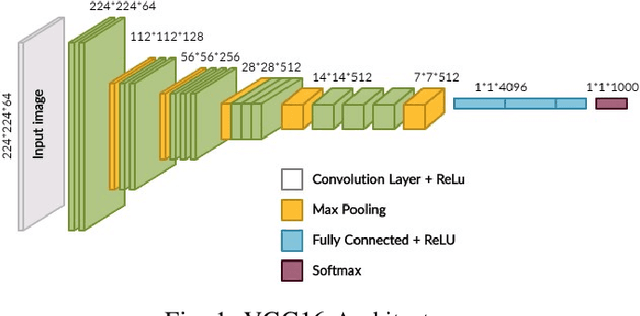
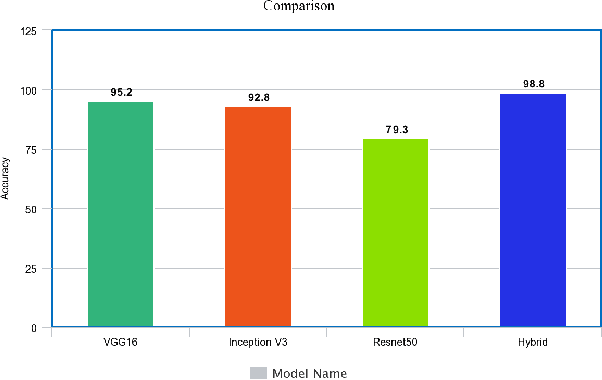
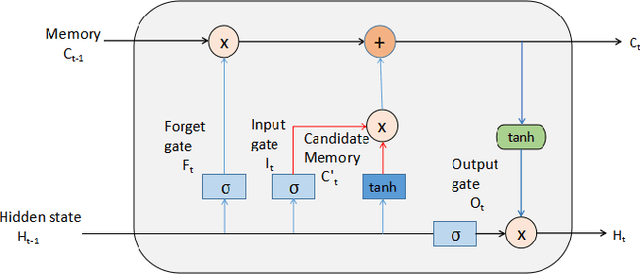
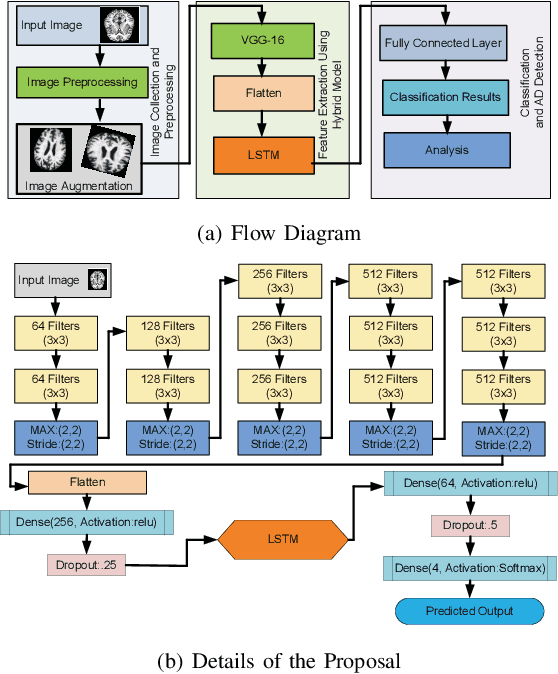
Abstract:Brain-related diseases are more sensitive than other diseases due to several factors, including the complexity of surgical procedures, high costs, and other challenges. Alzheimer's disease is a common brain disorder that causes memory loss and the shrinking of brain cells. Early detection is critical for providing proper treatment to patients. However, identifying Alzheimer's at an early stage using manual scanning of CT or MRI scans is challenging. Therefore, researchers have delved into the exploration of computer-aided systems, employing Machine Learning and Deep Learning methodologies, which entail the training of datasets to detect Alzheimer's disease. This study aims to present a hybrid model that combines a CNN model's feature extraction capabilities with an LSTM model's detection capabilities. This study has applied the transfer learning called VGG16 in the hybrid model to extract features from MRI images. The LSTM detects features between the convolution layer and the fully connected layer. The output layer of the fully connected layer uses the softmax function. The training of the hybrid model involved utilizing the ADNI dataset. The trial findings revealed that the model achieved a level of accuracy of 98.8%, a sensitivity rate of 100%, and a specificity rate of 76%. The proposed hybrid model outperforms its contemporary CNN counterparts, showcasing a superior performance.
Exploring Gene Regulatory Interaction Networks and predicting therapeutic molecules for Hypopharyngeal Cancer and EGFR-mutated lung adenocarcinoma
Feb 27, 2024Abstract:With the advent of Information technology, the Bioinformatics research field is becoming increasingly attractive to researchers and academicians. The recent development of various Bioinformatics toolkits has facilitated the rapid processing and analysis of vast quantities of biological data for human perception. Most studies focus on locating two connected diseases and making some observations to construct diverse gene regulatory interaction networks, a forerunner to general drug design for curing illness. For instance, Hypopharyngeal cancer is a disease that is associated with EGFR-mutated lung adenocarcinoma. In this study, we select EGFR-mutated lung adenocarcinoma and Hypopharyngeal cancer by finding the Lung metastases in hypopharyngeal cancer. To conduct this study, we collect Mircorarray datasets from GEO (Gene Expression Omnibus), an online database controlled by NCBI. Differentially expressed genes, common genes, and hub genes between the selected two diseases are detected for the succeeding move. Our research findings have suggested common therapeutic molecules for the selected diseases based on 10 hub genes with the highest interactions according to the degree topology method and the maximum clique centrality (MCC). Our suggested therapeutic molecules will be fruitful for patients with those two diseases simultaneously.
Securing Transactions: A Hybrid Dependable Ensemble Machine Learning Model using IHT-LR and Grid Search
Feb 22, 2024



Abstract:Financial institutions and businesses face an ongoing challenge from fraudulent transactions, prompting the need for effective detection methods. Detecting credit card fraud is crucial for identifying and preventing unauthorized transactions.Timely detection of fraud enables investigators to take swift actions to mitigate further losses. However, the investigation process is often time-consuming, limiting the number of alerts that can be thoroughly examined each day. Therefore, the primary objective of a fraud detection model is to provide accurate alerts while minimizing false alarms and missed fraud cases. In this paper, we introduce a state-of-the-art hybrid ensemble (ENS) dependable Machine learning (ML) model that intelligently combines multiple algorithms with proper weighted optimization using Grid search, including Decision Tree (DT), Random Forest (RF), K-Nearest Neighbor (KNN), and Multilayer Perceptron (MLP), to enhance fraud identification. To address the data imbalance issue, we employ the Instant Hardness Threshold (IHT) technique in conjunction with Logistic Regression (LR), surpassing conventional approaches. Our experiments are conducted on a publicly available credit card dataset comprising 284,807 transactions. The proposed model achieves impressive accuracy rates of 99.66%, 99.73%, 98.56%, and 99.79%, and a perfect 100% for the DT, RF, KNN, MLP and ENS models, respectively. The hybrid ensemble model outperforms existing works, establishing a new benchmark for detecting fraudulent transactions in high-frequency scenarios. The results highlight the effectiveness and reliability of our approach, demonstrating superior performance metrics and showcasing its exceptional potential for real-world fraud detection applications.
MLSTL-WSN: Machine Learning-based Intrusion Detection using SMOTETomek in WSNs
Feb 22, 2024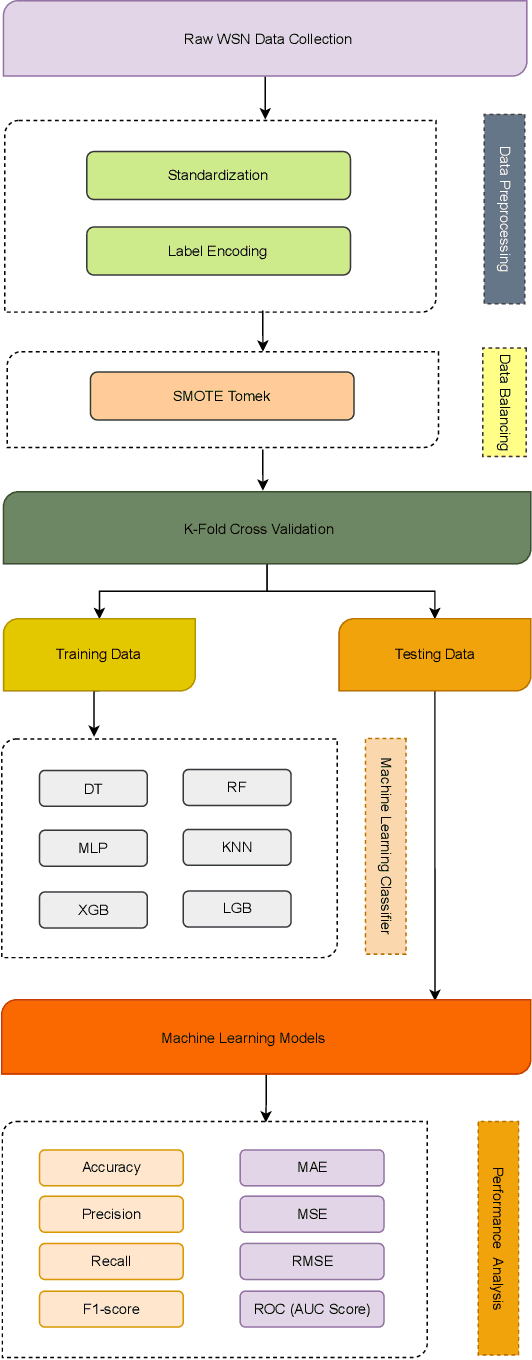

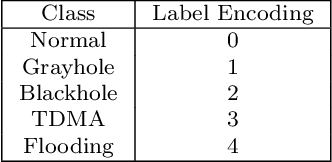
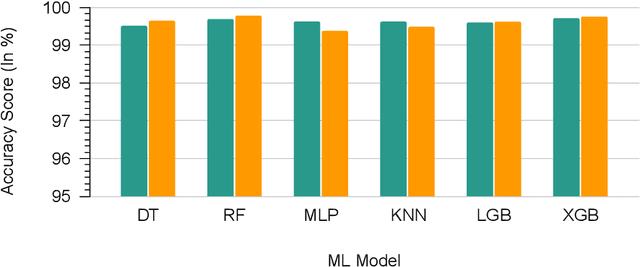
Abstract:Wireless Sensor Networks (WSNs) play a pivotal role as infrastructures, encompassing both stationary and mobile sensors. These sensors self-organize and establish multi-hop connections for communication, collectively sensing, gathering, processing, and transmitting data about their surroundings. Despite their significance, WSNs face rapid and detrimental attacks that can disrupt functionality. Existing intrusion detection methods for WSNs encounter challenges such as low detection rates, computational overhead, and false alarms. These issues stem from sensor node resource constraints, data redundancy, and high correlation within the network. To address these challenges, we propose an innovative intrusion detection approach that integrates Machine Learning (ML) techniques with the Synthetic Minority Oversampling Technique Tomek Link (SMOTE-TomekLink) algorithm. This blend synthesizes minority instances and eliminates Tomek links, resulting in a balanced dataset that significantly enhances detection accuracy in WSNs. Additionally, we incorporate feature scaling through standardization to render input features consistent and scalable, facilitating more precise training and detection. To counteract imbalanced WSN datasets, we employ the SMOTE-Tomek resampling technique, mitigating overfitting and underfitting issues. Our comprehensive evaluation, using the WSN Dataset (WSN-DS) containing 374,661 records, identifies the optimal model for intrusion detection in WSNs. The standout outcome of our research is the remarkable performance of our model. In binary, it achieves an accuracy rate of 99.78% and in multiclass, it attains an exceptional accuracy rate of 99.92%. These findings underscore the efficiency and superiority of our proposal in the context of WSN intrusion detection, showcasing its effectiveness in detecting and mitigating intrusions in WSNs.
Machine learning-based network intrusion detection for big and imbalanced data using oversampling, stacking feature embedding and feature extraction
Jan 22, 2024Abstract:Cybersecurity has emerged as a critical global concern. Intrusion Detection Systems (IDS) play a critical role in protecting interconnected networks by detecting malicious actors and activities. Machine Learning (ML)-based behavior analysis within the IDS has considerable potential for detecting dynamic cyber threats, identifying abnormalities, and identifying malicious conduct within the network. However, as the number of data grows, dimension reduction becomes an increasingly difficult task when training ML models. Addressing this, our paper introduces a novel ML-based network intrusion detection model that uses Random Oversampling (RO) to address data imbalance and Stacking Feature Embedding based on clustering results, as well as Principal Component Analysis (PCA) for dimension reduction and is specifically designed for large and imbalanced datasets. This model's performance is carefully evaluated using three cutting-edge benchmark datasets: UNSW-NB15, CIC-IDS-2017, and CIC-IDS-2018. On the UNSW-NB15 dataset, our trials show that the RF and ET models achieve accuracy rates of 99.59% and 99.95%, respectively. Furthermore, using the CIC-IDS2017 dataset, DT, RF, and ET models reach 99.99% accuracy, while DT and RF models obtain 99.94% accuracy on CIC-IDS2018. These performance results continuously outperform the state-of-art, indicating significant progress in the field of network intrusion detection. This achievement demonstrates the efficacy of the suggested methodology, which can be used practically to accurately monitor and identify network traffic intrusions, thereby blocking possible threats.
Empowering COVID-19 Detection: Optimizing Performance Through Fine-Tuned EfficientNet Deep Learning Architecture
Nov 28, 2023Abstract:The worldwide COVID-19 pandemic has profoundly influenced the health and everyday experiences of individuals across the planet. It is a highly contagious respiratory disease requiring early and accurate detection to curb its rapid transmission. Initial testing methods primarily revolved around identifying the genetic composition of the coronavirus, exhibiting a relatively low detection rate and requiring a time-intensive procedure. To address this challenge, experts have suggested using radiological imagery, particularly chest X-rays, as a valuable approach within the diagnostic protocol. This study investigates the potential of leveraging radiographic imaging (X-rays) with deep learning algorithms to swiftly and precisely identify COVID-19 patients. The proposed approach elevates the detection accuracy by fine-tuning with appropriate layers on various established transfer learning models. The experimentation was conducted on a COVID-19 X-ray dataset containing 2000 images. The accuracy rates achieved were impressive of 100% for EfficientNetB4 model. The fine-tuned EfficientNetB4 achieved an excellent accuracy score, showcasing its potential as a robust COVID-19 detection model. Furthermore, EfficientNetB4 excelled in identifying Lung disease using Chest X-ray dataset containing 4,350 Images, achieving remarkable performance with an accuracy of 99.17%, precision of 99.13%, recall of 99.16%, and f1-score of 99.14%. These results highlight the promise of fine-tuned transfer learning for efficient lung detection through medical imaging, especially with X-ray images. This research offers radiologists an effective means of aiding rapid and precise COVID-19 diagnosis and contributes valuable assistance for healthcare professionals in accurately identifying affected patients.
* Computers in Biology and Medicine [Q1, IF: 7.7, CS: 9.2]
 Add to Chrome
Add to Chrome Add to Firefox
Add to Firefox Add to Edge
Add to Edge